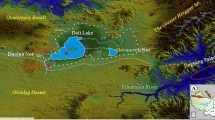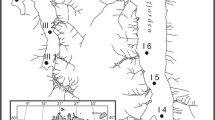Abstract
The grain size of lake sediments has been widely used to reconstruct environmental processes. However, the various components of lake sediments are influenced by different factors, and therefore the environmental significance of grain-size variations may be complex. For example, in situ authigenic biological siliceous components cannot be used to indicate variations in hydrodynamic conditions. Here we present a case study of the effects of diatoms on the grain size of the sediments of Lake Kanas in NW China. The analyses consist of measurements of bulk sediment grain size and biogenic silica, together with microscope observations. Based on both light and scanning electronic microscope observations, two large diatom species, Campylodiscus hibernicus Ehrenberg and Ellerbeckia arenaria (Moore) Crawford, were found to be abundant in sediment samples with a large bulk-sediment grain size, and they contributed substantially to the biogenic silica content and the measured bulk sediment grain size of the core. A quantitative assessment of the effects on grain size was made, and the study has a broad significance for evaluating the effects of diatoms on sediment grain-size distributions in other lakes. Because diatoms may deposit in situ or could be transported differently from other clastic material, the explanation of hydrodynamics could be misled if the influence of diatom has not been excluded. Therefore, we suggest BSi content should be tested to assess the diatom effect prior to grain-size analysis of lake sediments, together with microscope check of diatoms if BSi content is higher than 10%.






Similar content being viewed by others
References
An CB, Zhao J, Tao S, Lv Y, Dong W, Li H, Jin M, Wang Z (2011) Dust variation recorded by lacustrine sediments from arid Central Asia since ~ 15 cal ka BP and its implication for atmospheric circulation. Quat Res 75:566–573
Ashley GM (1978) Interpretation of polymodal sediments. Geology 86:411–421
Bale AJ, Morris AW (1991) Principles, methods, and application of particle size analysis: in situ size measurements of suspended particles in estuarine and coastal waters using laser diffraction. Cambridge University Press, New York
Barber KE, Battarbee RW, Brooks SJ, Eglinton G, Haworth EY, Oldfield F, Stevenson AC, Thompson R, Appleby PG, Austin WEN (1999) Proxy records of climate change in the UK over the last two millenia: documented change and sedimentary records from lakes and bogs. J Geol Soc 156:369
Battarbee RW (1973) A new method for the estimation of absolute microfossil numbers, with reference especially to diatoms. Limnol Oceanogr 18(4):647–653
Chen F, Qiang M, Zhou A, Xiao S, Chen J, Sun D (2013) A 2000-year dust storm record from Lake Sugan in the dust source area of arid China. J Geophys Res Atmos 118:2149–2160
Elisabeth D, Kai H, Bernhard D, Jin H, Georg S, Yang S, Frank L (2015) Early to mid-Holocene lake high-stand sediments at Lake Donggi Cona, northeastern Tibetan Plateau, China. Quat Res 79:325–336
Fanning KA, Pilson ME (1973) On the spectrophotometric determination of dissolved silica in natural waters. Anal Chem 45:136–140
Flemming BW (2007) The influence of grain-size analysis methods and sediment mixing on curve shapes and textural parameters: implications for sediment trend analysis. Sediment Geol 202:425–435
Gammon PR, Neville LA, Patterson RT, Savard MM, Swindles GT (2017) A log-normal spectral analysis of inorganic grain-size distributions from a Canadian boreal lake core: towards refining depositional process proxy data from high latitude lakes. Sedimentology 64(3):609–630
Gao Q, Rioual P, Chu G (2016) Lateglacial and early holocene climatic fluctuations recorded in the diatom flora of Xiaolongwan maar lake, NE China. Boreas 45:61–75
Huang X, Chen F, Xiao S, Yanbin LV, Chen JA, Zhou A (2008) Primary study on the environmental significances of grain-size changes of the Lake Bosten sediments. J Lake Sci 20:291–297 (in Chinese)
Lecointe C, Coste M, Prygiel J (1993) OMNIDIA: software for taxonomy, calculation of diatom indices and inventories management. Hydrobiologia 269(270):509–513
Levina OV, Karabanov EB (2007) Modern accumulation rates of biogenic silica in Baikal bottom sediments: significance of diatom species composition. Russ Geol Geophys 48:483–490
Lin X, Rioual P, Peng W, Yang H, Huang X (2018) Impact of recent climate change on Lake Kanas, Altai Mountains (N.W. China) inferred from diatom and geochemical evidence. J Paleolimnol 59:461–477
Liu J, Wang Y, Li T, Tian F, Yang J (2016) Comparison of grain-size distributions between nearshore sections and a deep-water sediment core from Dali Lake, North China, and inferred Holocene lake-level changes. J Paleolimnol 56:123–135
Lu H, An Z (1998) Pretreated methods on loess-palaeosol samples granulometry. Chin Sci Bull 43:237–240
Middleton GV (1976) Hydraulic interpretation of sand size distributions. Geology 84:405–426
Mortlock RA, Froelich PN (1989) A simple method for the rapid determination of biogenic opal in pelagic marine sediments. Deep Sea Res Part A Oceanogr Res Pap 36:1415–1426
Oldfield F, Battarbee RW, Boyle JF, Cameron NG, Davis B, Evershed RP, Mcgovern AD, Jones V, Thompson R, Walker R (2010) Terrestrial and aquatic ecosystem responses to late Holocene climate change recorded in the sediments of Lochan Uaine, Cairngorms, Scotland. Quat Sci Rev 29:1040–1054
Peng Y, Xiao J, Nakamura T, Liu B, Inouchi Y (2005) Holocene East Asian monsoonal precipitation pattern revealed by grain-size distribution of core sediments of Daihai Lake in Inner Mongolia of north-central China. Earth Planet Sci Lett 233:467–479
Qiang M, Liu Y, Jin Y, Song L, Huang X, Chen F (2014) Holocene record of eolian activity from Genggahai Lake, northeastern Qinghai-Tibetan Plateau, China. Geophys Res Lett 41:589–595
Rahman R, Plater AJ (2014) Particle-size evidence of estuary evolution: a rapid and diagnostic tool for determining the nature of recent saltmarsh accretion. Geomorphology 213:139–152
Rawlence DJ (1992) Paleophycology of Long Lake, Saint-John County, New-Brunswick, Canada, based on diatom distribution in sediments. Can J Bot 70:229–239
Schillereff DN, Chiverrell RC, Macdonald N, Hooke JM (2015) Hydrological thresholds and basin control over paleoflood records in lakes. Geology 44(1):43–46
Snoeijs P, Busse S, Potapova M (2010) The importance of diatom cell size in community analysis. J Phycol 38:265–281
Sun D, Bloemendal J, Rea DK, Vandenberghe J, Jiang F, An Z, Su R (2002) Grain-size distribution function of polymodal sediments in hydraulic and aeolian environments, and numerical partitioning of the sedimentary components. Sediment Geol 152:263–277
Watermann F, Hillebrand H, Gerdes G, Krumbein W, Sommer U (1999) Competition between benthic cyanobacteria and diatoms as influenced by different grain sizes and temperatures. Mar Ecol Prog 187:77–87
Wu J, Liu W, Zeng H, Ma L, Bai R (2014) Water quantity and quality of six lakes in the arid Xinjiang Region, NW China. Environ Process 1:115–125
Xiao JL, Inouchi Y, Kumai H, Yoshikawa S, Kondo Y, Liu TS, An ZS (1997) Biogenic silica record in Lake Biwa of central Japan over the past 145,000 years. Quat Res 47(3):277–283
Yang Z, Zhang X (2010) Scientific research on Kanas natural heritage. Xinjiang Institute of Ecology and Geography Chinese Academy of Science. Xinjiang People’s Publishing House, Urumqi, pp 16–17 (in Chinese)
Zhu L, Zhen X, Wang J, Lü H, Xie M, Kitagawa H, Possnert G (2009) A ~ 30,000-year record of environmental changes inferred from Lake Chen Co, Southern Tibet. J Paleolimnol 42:343–358
Zhu B, Yu J, Qin X, Rioual P, Zhang Y, Liu Z, Mu Y, Li H, Ren X, Xiong H (2013) Identification of rock weathering and environmental control in arid catchments (northern Xinjiang) of Central Asia. J Asian Earth Sci 66:277–294
Acknowledgements
This study was funded by the National Key Research and Development Program of China (Awards 2017YFA0603402 and 2017YFA0603403) and the National Natural Science Foundation of China (Award 41571182). We thank Prof. Thomas J. Whitmore, Prof. Irene Gregory-Eaves and two anonymous reviewers for their helpful suggestions for improving the paper. We also thank W. Peng for help with fieldwork; Dr. Selvaraj Kandasamy for providing guidance in the laboratory; and L. Wang, Z.Q. Wang, Q.Q. Liu and H.W. Wang for their assistance with the biogenic silica measurements.
Author information
Authors and Affiliations
Corresponding author
Additional information
Publisher's Note
Springer Nature remains neutral with regard to jurisdictional claims in published maps and institutional affiliations.
Rights and permissions
About this article
Cite this article
Huang, X., Sun, M., Xiang, L. et al. The effect of diatoms on the grain size of lake sediments: a case study of the sediments of Lake Kanas. J Paleolimnol 63, 101–111 (2020). https://doi.org/10.1007/s10933-019-00104-1
Received:
Accepted:
Published:
Issue Date:
DOI: https://doi.org/10.1007/s10933-019-00104-1




